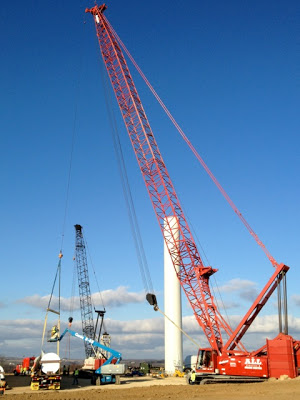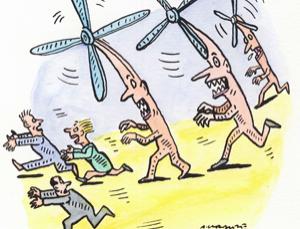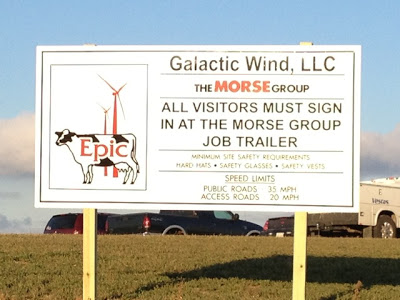by jboullion | Nov 14, 2012 | Uncategorized
RENEW Wisconsin‘s Michael Vickerman weight in on the recent changes in Wisconsin politics, and what they mean for the future of renewable energies. From this article in Midwest Energy News by Dan Haugen.
Will changing political winds in Wisconsin mean another new direction for wind energy policy in the state?
Wisconsin Republicans reclaimed control of the state’s senate last week, five months after recall elections tipped the balance to Democrats. Republicans will now hold power by a wider margin in 2013 than they held in 2011.
 |
| A wind farm near Fond du Lac, Wisconsin. Renewable energy advocates are expecting another challenge to the state’s wind siting rules. (Photo by Digidave via Creative Commons) |
Wind energy advocates are worried that might mean another attempt to repeal the state’s wind farm siting rules, which limit restrictions that local governments can place on proposed wind developments.
And one Republican state senator has already announced plans to seek a repeal of the state’s renewable electricity standard, though a renewable advocacy group doubts the bill will gain enough support to pass.
Hopes for bipartisanship
Overall, RENEW Wisconsin program and policy director Michael Vickerman expects less hostility and more acceptance of the fact that renewable energy plays a growing role in the state’s economy.
“We are hearing that there are Republican senators that want to introduce positive legislation on renewable energy next year, and they want to do so in a bipartisan fashion,” Vickerman said.
RENEW Wisconsin is a member of RE-AMP, which also publishes Midwest Energy News.
While Republicans haven’t announced their energy agenda, RENEW Wisconsin is concerned about a proposal by Republican state Sen. Frank Lasee that would un-do the state’s wind farm siting policy.
“He’s spearheading a one-person jihad against wind energy,” Vickerman said.
Wisconsin adopted statewide wind siting rules in 2011 that put boundaries on the local zoning and permitting regulations, which had delayed or derailed wind projects in some counties.
In March, Lasee introduced a bill that would have rolled back those rules, putting wind developers back at the mercy of a messy patchwork of local rules, some of which were, in Vickerman’s words, “a never-ending obstacle course” meant to discourage any projects.
Lasee’s effort last spring came up one vote short when Republicans had a 17-16 margin in the state senate. Next year, Lasse’s party is expected to hold an 18-15 majority.
“We survived, really, by the skin of our teeth,” Vickerman said. “All other things being equal, we have to find another Republican senator who will stand [for the wind siting rules.]”
RPS challenge?
The American Legislative Exchange Council, a conservative policy group that promotes identical, model legislation across the country, says it plans to make repealing state renewable mandates a high priority in 2013.
State Sen. Glenn Grothman, a Republican from Sheboygan, has already announced plans for a bill that would freeze Wisconsin’s renewable standard at its 2012 levels.
“The 10 percent renewable portfolio standard imposed on Wisconsin utilities in 2006 was a mistake,” Grothman said in a press release. (The senator’s office didn’t return a phone call last week.)
Vickerman said he is “not particularly worried” about Grothman’s bill. That’s because renewable energy has too many allies — from landfill operators to equipment manufacturers — who understand its importance to growing Wisconsin’s economy.
“He is looking at legislation that would not only scale back commitments to wind energy, but also solar, biogas, landfill gas, hydro — all the resources are covered,” Vickerman said.
The legislation would also have very little practical effect, Vickerman said, because most of the state’s utilities have met their requirements for 2015 already.
Gary Radloff, director of Midwest energy policy analysis for the Wisconsin Bioenergy Initiative at the University of Wisconsin-Madison, said it’s tough to generalize about legislators’ positions on energy.
“My experience has been that there’s a pretty broad continuum of views on energy, and that there’s people within the Republican caucus who see the benefits of renewables, especially bioenergy,” Radloff said.
Renewable energy has broad support from the public and businesses in Wisconsin, Radloff said. He thinks there’s more recognition today that a broad, all-out attack on renewables would not be popular.
His advice for lawmakers: “I would urge elected officials from both parties to go slow on dramatic energy policy change around renewables,” he said. “I think it’s really important that they go slow, keep an open mind, and recognize that the world is changing.”
See the original article and comments here.
by jboullion | Nov 12, 2012 | Uncategorized
More information
Michael Vickerman
mvickerman@renewwisconsin.org
608.255.4044,ext. 2
State’s Renewable Standard Delivers Positive Results
Most utilities already meeting 2015 targets
Most Wisconsin electricity providers have already acquired all the renewable energy supplies they need to meet the state’s 10% target in 2015, according to the Public Service Commission (PSCW).
The agency’s annual compliance review showed that nearly 9% of electricity sold by in-state electricity providers in 2011 originated from such renewable energy resources as sunlight, biogas, hydro, landfill gas and wind, compared with 3% in 2006.
“By any measure, the state’s Renewable Energy Standard (RES) has been an unqualified success,” said Michael Vickerman, program and policy director for RENEW Wisconsin. “From the standpoint of job creation, resource diversity, price stability, environmental protection and revenue generation, the RES has delivered exceptional value to a state that is very dependent on imported fossil fuels for electricity generation.”
Passed in 2006, the RES has been the most powerful policy for driving growth in renewable electricity sales. Yet with so many electricity providers already in compliance with their 2015 requirements, the prospects for new investments in home-grown energy sources are uncertain.
“Right now, we don’t have a policy in place for directing investments into clean energy after 2015,” Vickerman said. “If we want to reap the economic and environmental benefits that come with renewables, state lawmakers will have to extend the Renewable Energy Standard or adopt a successor policy.”
“Investments in renewable resources not only supply Wisconsin utility customers with clean energy, they also generate work opportunities for local manufacturers and businesses, additional revenue for local governments, and income for farmers,” said Vickerman.
“Renewable energy should be the cornerstone of an economic development strategy that aims to increase the state’s workforce and expand investment opportunities,” Vickerman said. “We look forward to working with the Governor and the next Legislature to put in place a realistic, low-cost policy framework that maintains the momentum building from the current RES.”

by jboullion | Nov 6, 2012 | Uncategorized
It’s a great day to celebrate wind energy! The first tower section of Epic’s six-turbine Galactic Wind project is now standing. These will be Vestas V-82 turbines, and they are going up in Springfield Township west of Highway 12.

by jboullion | Nov 2, 2012 | Uncategorized
Hilltop turbines are being blamed for myriad maladies. What is the truth behind these outlandish claims? Simon Chapman debunks these claims in this article from the New Scientist.
 NEW technology has long attracted “modern health worries”. Microwave ovens, television and computer screens and even early telephony all caused anxiety in their time. More recently, cellphones and towers, Wi-Fi and smart electricity meters have followed suit.
NEW technology has long attracted “modern health worries”. Microwave ovens, television and computer screens and even early telephony all caused anxiety in their time. More recently, cellphones and towers, Wi-Fi and smart electricity meters have followed suit.
Another is gathering attention; the very modern malaise known as wind turbine syndrome. I set out to collect the conditions attributed to wind farm exposure. Within hours, I’d found 50 often florid assertions about different illnesses. Today my total sits at 198, with a range redolent of Old Testament plagues.
The list includes “deaths, yes, many deaths”, none of which have ever come to the attention of a coroner, cancers, congenital malformations, and every manner of psychiatric problem. But mostly, it includes common health problems found in all communities, with wind turbines or not. These include greying hair, energy loss, concentration lapses, weight gain and all the problems of ageing. Sleep problems are mentioned most, but insomnia is incredibly common. Animals get a look in. Chickens won’t lay; earthworms vanish; hundreds of cattle and goats die horrible deaths from “stray electricity”.
In a 35-year career in public health, I have never encountered anything quite so apocalyptic. I’ve visited wind farms and compared their gentle swoosh to the noises that all city dwellers live with daily. Quickly, this phenomenon began to tick psychogenic boxes.
There are several reasons to suspect that the unrecognised entity of wind turbine syndrome is psychogenic: a “communicated” disease spread by anti-wind interest groups, sometimes with connections to fossil fuel interests. People can worry themselves sick.
Firstly, there are the temporal problems. Wind farms appeared some 20 years ago in the US. There are now just shy of 200,000 turbines globally. But the first recorded claims that they caused disease came a decade later. Two rural doctors, one in the UK and the other in Australia, made claims repeated widely in newspapers but never published in any journal. Turbines have come to be blamed for chronic conditions like (amazingly) lung and skin cancer, diabetes, multiple sclerosis and stroke. But importantly also acute symptoms, that according to Australia’s high priestess of wind turbine syndrome, Sarah Laurie, an unregistered doctor, can commence within 20 minutes of exposure. If true, what happened in the early complaint-free years?
Then there’s the issue of clustering. The European wind industry sees the phenomenon as largely anglophone, and even then, only in particular regions and around certain farms. Many sites have run for years without complaint. Others, legendary for their vocal opponents even before start up, are hot beds of disease claims. So if turbines were inherently noxious, why do they cut such a selective path? Why do citizens of community-owned turbines in Germany and Denmark rarely complain? Why are complaints rare in western Australia, but rife in several eastern Australian communities?
Opponents readily concede that only a minority of those exposed report being ill but explain this via the analogy of motion sickness: it only happens to those who are susceptible. How then to explain that whole regions and indeed nations, have no susceptible people? The key factor seems to be the presence or absence of anti-wind activists, generally from outside the area.
It is clear the presence of these anti-wind “vectors” is required. Communities which have for years accepted the farms can erupt when activists arrive, spreading alarm and listing health problems. Prominent among these in Australia are wealthy conservative landowners appalled by the very visible presence of the tall green-energy totems, a constant reminder of bucolic decay and the “upstairs-downstairs” disdain they have for those needing income from their often hilly, poorer quality land.
The fact that money seems to be a magic antidote to these ailments further undermines the claims. Health complaints are as rare as rocking horse excrement among turbine hosts. Complaints are rare from those financially benefitting from communal ownership arrangements. It tends to be neighbours of those hosting turbines who make the link with illness. They see the turbines, dislike them and dwell on their misfortune. The perceived injustice can eat away at some, fomented by organised groups.
Wind companies also report residents approaching them with extensive renovation wish lists. One told me of a request for a house to be moved to a lake shore. In rural Australia, residential buy-outs by mining companies are common. Word spreads about shack owners who got lucky. So when a cashed-up company appears, it is understandable that some may see their ticket out via protracted complaints.
Opponents also claim that confidentiality clauses are used to gag hosts, so they can’t speak up about illnesses. I’ve seen several contracts and, predictably, none involve signing away common law rights to claims of negligence.
Finally, there are the apocryphal tales about many families having to abandon their homes. Mysteriously, address lists are never produced. Abandoning unsaleable properties is a sad part of rural decay, a fact which seems to escape fly-in, fly-out climate change denialists.
Previous modern health worries dissipated when the predicted health mayhem never emerged and the feared exotic agents became thoroughly familiar. Hysteria about cellphone towers had its heyday in the late 1990s, at least in Australia, but is rare today. With 17 reviews of the evidence on harm caused by wind farms consistent in their assessment of insignificant risk, how long can this one last?
Simon Chapman is professor in public health at the University of Sydney, Australia. Find the original article here.
by jboullion | Oct 31, 2012 | Uncategorized
Now is the time to make sure you know where your candidates stand on the day’s most important issues. Two important issues that will have a major impact on our state’s future are clean energy and energy efficiency.
Voters typically consider energy a national issue, but state-level politics often have as much or more impact on our energy future. In Wisconsin, state laws determine the how much of our electricity comes from renewable sources like wind and solar power. Additionally, programs like Focus on Energy, the statewide energy efficiency program, help homeowners and businesses save millions of dollars on energy bills.
Despite these laws and programs, we still send over $12 billion out of state each year to purchase dirty fossil fuels. Increasing our commitment to clean energy and energy efficiency could help Wisconsin become more energy independent, clean our air and water, and create thousands of jobs.
Unfortunately, legislators voted to significantly cut funding to Focus on Energy in the last legislative session, despite the program’s proven success; it saves homeowners and businesses $2.50 for every $1 invested in the program. Now is the time to move clean energy and energy efficiency policies forward, not backward.
A recent poll by the bipartisan research team of Public Opinion Strategies and Fairbank, Maslin, Metz and Associates found that Wisconsinites overwhelmingly support clean energy and energy efficiency. In fact, the poll found that 85 percent of Wisconsin voters support increasing the use of wind energy to meet our state’s future energy needs, and 89 percent support increasing the use of solar energy. Additionally, 84 percent said they would support policies requiring 30 percent of Wisconsin’s electricity to come from renewable sources. This is well above the current standard of 10 percent by 2015, which utilities have largely met.
By passing clean energy policies and increasing funding for money-saving programs like Focus on Energy in the next legislative session, legislators can help create Wisconsin jobs. Companies like Milwaukee’s Helios SolarWorks, a solar panel manufacturer, Manitowoc’s Orion Energy Systems, a leader in lighting efficiency, Prairie du Sac’s Tower Technologies, a renewable energy installer, and hundreds more can create more jobs if leaders work together to advance clean energy and energy efficiency policies.
In addition, such policies could attract new companies to Wisconsin and make our state a leader in the rapidly expanding clean energy economy. In April,
Ibisworld.com listed solar panel manufacturing (No. 2) and green and sustainable building construction (No. 9) among the nation’s top 10 fastest-growing industries. The poll found that more than two-thirds of voters believe clean energy and energy efficiency will create jobs and investing in these industries now can help ensure Wisconsin remains economically strong for decades.
At a time when our state and nation remain deeply divided on many issues, clean energy and energy efficiency unite people of all political stripes. With less than two weeks to the election, now is the time to ask your candidates where they stand on these important issues.
Keith Reopelle is the senior policy director at Clean Wisconsin. For more information, visit www.cleanwisconsin.org. Find the original article here.




